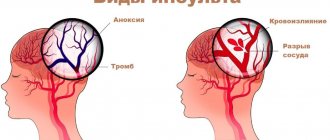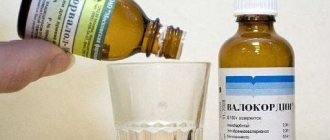Corvalol is a popular medicine, especially among older people. Available in the form of drops and tablets. In the minds of many, it is used when “the heart is in pain.” In fact, this combination drug belongs to the group of sedatives and hypnotics. It is not easy to find out the whole truth about Corvalol. Despite the fact that the drug is decades old, even doctors have ambivalent attitudes towards it.
Professor Pavel Vorobyov, head of an organization engaged in research into cost-effectiveness in pharmacology, believes that Corvalol should be classified as a hard drug and sold only by prescription. Its use prevents patients from seeing a doctor on time and hides the symptoms of serious diseases.
Also, uncontrolled use of the drug can lead to the development of side effects, addiction and poisoning.
Corvalol drops: composition
The drug contains mint oil, ethyl bromizovalerianate and phenobarbital.
Peppermint is known for its ability to have a calming effect on the nervous system. In addition, mint helps blood vessels dilate.
Phenobarbital is a special component that enhances the effect of other substances that make up Corvalol. In particular, it contributes to the rapid manifestation of a sedative effect on the central nervous system and the body as a whole. Thanks to phenobarbital, Corvalol makes it easier for a person to go to sleep, which is especially important after suffering stress.
Ethyl bromizovalerate is responsible for the antispasmodic effect accompanied by a strong sedative effect.
Drops contain alcohol as an auxiliary component.
Other Adverse Effects
Self-medication with Corvalol can mask the symptoms of more serious diseases, such as cancer. The components of the drug cannot be called beneficial to health. In addition, the drug may have a pronounced placebo effect. On the one hand, this is good and increases its effectiveness. On the other hand, patients stop taking medications that are really necessary for diseases of the cardiovascular system. Patient adherence to treatment is a big problem in cardiology.
Yes, perhaps they act more slowly and do not bring relief immediately, but it is their use that increases life expectancy and reduces the risk of heart attacks and strokes (statins, antihypertensive drugs, antiplatelet agents). Because they act on the mechanisms of disease development, and do not simply mask the symptoms.
Corvalol drops at night can become for an elderly person an imaginary concern for their health and a ritual of self-soothing. Then, if symptoms intensify or new ones appear, he does not go for examination, but simply increases the dose. This is especially true for residents of areas with low access to medical care.
How many drops of Corvalol to take?
Most often you can find Corvalol in drops. It is sold in glass vials equipped with a dropper. Therefore, the question most often arises of how many drops you need to drink in each specific case. There is an opinion that it is correct to take into account the following calculation: 1 drop per 1 year of life. However, medicine says that this is wrong.
A single dose should not exceed 30 drops. Corvalol concentrate must be dissolved in a sufficient amount of water. The more liquid you take for dilution, the less pronounced the taste of the medicinal solution will be. In special cases, the single dose can be increased to 50 drops.
You can repeat the reception up to three times a day. It is important that the daily dose does not exceed 100 drops.
It is not recommended to take Corvalol as a course without consulting a doctor. Unlike long-term use, a one-time use during stress does not pose a danger to humans, however, constant use of the drug can also have a negative effect on the body.
Analogs
Level 4 ATC code matches:
Belloid
Corvaldin
Bellaspon
Korvaltab
Bellataminal
Reladorm
Valocordin
Analogs with a similar mechanism of action: Amizil , Bromizoval , Valemidin , Valerian , Valocordin , Doppelgerts Melissa , Potassium bromide , Corvaldin , Novo-Passit , Notta , Passifit , Persen , Sympatil , Songa Knight , Bromcamphor , Circulin , Dexdor .
Which is better: Corvalol or Valocordin?
Valocordin is a drug based on ethyl bromizovalerianate (18.4 mg/g), phenobarbital (18.4 mg/g), mint oil (1.29 mg/g), hop oil (0.18 mg/g), 96% th ethanol (469.75 mg/g), purified water (411.97 mg).
It can be noted that the difference in the composition of Valocordin and Corvalol is very insignificant. The only difference is that the first contains a small amount of hop oil, which has a calming and antispasmodic effect .
Experts, when asked how Valocordin differs from Corvalol, answer that the drugs are absolutely identical. Both of them quickly eliminate discomfort and pain in the heart, and, if used in a timely manner, can prevent an attack of angina and myocardial infarction .
Since Corvalol is a domestic drug, and Valocordin is produced by the German company Krewel Meuselbach GmbH, the former is a more affordable product (a bottle of Valocordin , depending on the container, costs from 130 to 300 rubles, while Corvalol drops can be bought for 11-40 rubles).
Overdose
Due to the fact that the drug contains bromine compounds, an overdose can provoke:
- depression;
- rhinitis;
- inflammation of the conjunctiva;
- lack of coordination;
- drug dependence.
With prolonged use, patients note the appearance of dizziness, increased drowsiness, and the appearance of allergic reactions.
With liver failure, a rash may appear, accompanied by severe itching. Each meal will make the rash worse, even if Corvalol is stopped. Patients with phenobarbital poisoning note the appearance of edema, which indicates an exacerbation of renal failure. If such a reaction occurs, the patient should urgently call a doctor and, if necessary, be hospitalized.
Placebo effect
The literature describes placebo effects for Corvalol and the similar composition Valocordin1. Thus, elderly people living abroad, former citizens of Russia (USSR), sometimes at very old age, asked to send these particular drugs, because previously they “helped great.” What “used to be” was 20 years ago, they were younger and healthier, did not interest anyone. Explanations from local doctors and relatives that there are more effective, modern medicines did not reassure them. But the most interesting thing is that the new medications themselves did not help. The “tried and true” were needed. Then they resorted to a combination of active ingredients according to the instructions from Corvalol to produce exactly the same ones. But no, only the “old” Valocordin or Corvalol were needed. When patients did get “their” drugs, they began taking them with great pleasure and hope. Usually they helped, just as “effectively” as many years ago.
For many elderly patients, it is necessary to weigh the benefits and possible harm, additional risks when taking Corvalol. Often this is psychological dependence and the effect of self-hypnosis.
Do not take medications on your own and always consult a doctor.
Special reactions to the components of the drug
The following negative reactions were observed in patients taking Corvalol:
- nausea;
- vomit;
- constipation;
- feeling of heaviness in the stomach;
- increased weakness;
- dizziness;
- hallucinations;
- headaches in the frontal lobe;
- anemia;
- thrombocytopenia;
- difficulty breathing.
Habituation and Dependence
Addiction to frequent uncontrolled use often causes addiction and dependence. Phenobarbital has an accumulation effect in the body. Also, over time, with long-term use, the body’s sensitivity to the previous dose decreases and the person begins to gradually increase it, since he does not receive relief as before.
A person cannot stop taking it on his own, as a strong withdrawal syndrome develops. In mild cases, withdrawal syndrome is manifested by anxiety, tremors, increasing weakness throughout the body, dizziness, nausea, vomiting, sleep disturbance, dizziness, and the development of fainting. In severe cases, convulsions and delirium are possible.
Is it possible to use Corvalol for VSD?
Vegetative-vascular dystonia is not a diagnosis, but this condition well characterizes the well-being of many people. It is accompanied by fatigue, dizziness that occurs with a sudden change in body position, including darkening of the eyes. Dystonia is a condition of blood vessels in which they do not have time to respond to a change from a horizontal to a vertical body position, and also cannot expand in a timely manner to allow more blood to pass through during sports activities.
In this case, the effect of Corvalol is explained by several factors:
- mint makes blood vessels more elastic;
- bromine reduces anxiety, which increases the symptoms of VSD;
- phenobarbital enhances the effect of the other two components, improving sleep.
Indications for use
The medication in solid form is prescribed for the following symptoms:
- increased irritability;
- vegetative-vascular dystonia;
- hypertensive diseases;
- disturbed sleep;
- spasms of the coronary vessels.
Drops are effective for conditions such as:
- central nervous system disorder;
- neurotic state;
- mildly disturbed heartbeat;
- disturbed sleep.
How to take Corvalol for herpes
The effectiveness of Corvalol against the herpes virus, which manifests itself on the lips in the form of ulcers, has been noted. It is important to use Corvalol at the first sign of a painful sore on the lips. In order to prevent the disease from developing, it is necessary to wet a piece of cotton wool or one end of a cotton swab with Corvalol and apply it to the ulcer. A tingling sensation will indicate that the drug has begun to destroy the ulcer. Alcohol, having a drying effect, will speed up recovery. You need to repeat the procedure several times a day until the tingling stops.
Contraindications
For two types of medicinal drugs:
- acute renal and liver failure;
- lactation period;
- epilepsy;
- excessive sensitivity to the drug.
Tablets are also contraindicated in the following cases:
- lactose indigestibility;
- acute form of chronic heart failure;
- lack of glucose-galactose malabsorption;
- susceptibility to bromine;
- pregnancy.
Rehabilitation
Addiction becomes physical very quickly. This means that the nerve synapses can no longer function normally without a new dose of the drug. Therefore, with a sharp refusal of medications, withdrawal syndrome begins, which is manifested by a decrease in blood pressure, psychosis, and impaired consciousness.
Considering the high risks of death if the drug is abruptly discontinued, rehabilitation should be comprehensive and take place in a hospital.
This rehabilitation complex necessarily includes drug therapy, body cleansing, psychological support and resocialization. Effective and modern centers for recovery from drug addiction are required to work with codependent people. This complex of treatment measures allows you to achieve stable remission with minimal risk of failure.
Causes of sleep disorders
When treating chronic insomnia or other forms of sleep disorders with various medications, it is important to determine the reason why the disorder developed. Among the most common factors identified in people who consult a doctor with complaints of insomnia are the following.
Stress. Tense relationships in a team, the need to withstand the “career race”, a high level of professional or personal responsibility and much more can cause chronic stress and, as a result, the development of insomnia. In addition, this condition in adults can be caused by other circumstances: family quarrels, divorce, litigation, financial difficulties, change of place of residence, loss of property, health problems, etc.
Non-compliance with the daily routine. Maintaining natural biorhythms is important for quality sleep. Sleep is a state that begins gradually with the slowing down of some processes in the body and the activation of others. So, when darkness sets in (that is, in the absence of light stimuli), changes occur in the human body that serve as a signal for the transition to sleep. If you ignore biorhythms (working night shifts, the habit of sitting at the computer at night, etc.), these mechanisms are disrupted and sleep problems may gradually develop. Moreover, even returning to normal mode does not always produce the expected effect. The time it takes to fall asleep can be several hours.
Taking certain medications. Insomnia is often caused by the use of the following medications: antihypertensive drugs (alpha and beta blockers), decongestants, antiepileptics, respiratory drugs (theophylline), hormones, etc.
Bad habits. This category includes all factors that in one way or another negatively affect the functioning of internal organs and the psyche. Taking substances that have a stimulating or depressing effect (nicotine, alcohol, caffeine, etc.), the habit of having a large dinner before bed, a sedentary lifestyle of adults and other factors can desynchronize the mechanisms responsible for sleep and its quality.
Some diseases. Insomnia is often caused by symptoms of some disease. These may be breathing problems due to ARVI, joint pain due to arthritis, headache due to hypertension, etc. Such symptoms can acquire the properties of distractions that interfere with sleep, and the underlying disease that causes such symptoms can sometimes negatively affect biochemical processes, responsible for sleep.
Negative environmental factors. The conditions in which you fall asleep are very important for the quality of your sleep. Therefore, with frequent or constant exposure to irritants in the form of bright light, increased noise levels, an uncomfortable bed, etc., falling asleep becomes increasingly difficult for an adult, and chronic insomnia may develop over time.
Symptoms of sleep disorders
Many people are mistaken in believing that sleep disorders are necessarily associated with its complete absence or inability to fall asleep without sleeping pills or sedatives. Insomnia has many more manifestations, and it can develop so imperceptibly and gradually that a person sometimes does not even connect the state of chronic fatigue, apathy, and decreased tone with how and how much he sleeps. Therefore, it is important to pay attention to the following symptoms that indicate sleep problems.
- Difficulty falling asleep. It can take more than an hour from the moment you get into bed until you fall asleep. This time is not reduced even if you are physically tired.
- The desire to sleep disappears after you go to bed, although it was clearly felt before.
- During sleep, you hear everything happening around you.
- When you try to sleep, you begin to be disturbed by heat, cold, an uncomfortable bed, any sensations in your body - any factors that did not bother you before.
- Even if sleep comes quickly, after a short period of time you wake up and can no longer fall asleep.
- In the morning there is no feeling of freshness and vigor, and during the day you are haunted by drowsiness and lack of energy.
- Superficial sleep, with frequent and causeless awakenings (not related to the desire to drink, go to the toilet, wrap yourself more tightly in a blanket, etc.).
These are the main symptoms of insomnia, which can be supplemented by others (for example, irritability, mood swings, lack of appetite or, conversely, bouts of insatiable hunger, etc.).
Historical facts
The German scientist Adolf Bayer is considered the discoverer of barbituric acid. It was not until 1903 that barbituric acid derivatives began to be marketed as remedies for insomnia and stress.
The first drug to hit the market was Veronal. From 1903 to 1930, the first facts of abuse of barbituric acid derivatives were already recorded. But the lack of an alternative led to the continued use of barbiturates until the 1960s.
After studies and evidence of dependence on barbituric acid derivatives were published, these drugs were abandoned. Now barbiturates are considered illegal drugs, after taking which you cannot drive a car, do work that requires quick reactions and on which the lives of other people depend.
Coding
Coding is a scientifically unproven addiction treatment method. Coding is based on the use of hypnosis or suggestion methods. In practice, these methods do not produce results, because physical dependence should be treated only in combination with long-term psychological therapy and drug support.
If you are offered coding as a method of treatment for addiction, you should not contact such centers or clinics. Coding is a technique that extracts money from the patient, but does not produce results.
Why you can’t undergo rehabilitation at home or on an outpatient basis
You cannot undergo rehabilitation for barbituromania at home. Remember that abrupt refusal of these drugs leads to life-threatening disorders.
Not every patient can receive adequate symptomatic therapy as an outpatient. The doctor cannot provide daily psychological support.
At home, the patient always has access to friends and potential distributors of the drug. If a patient needs to travel to a doctor for consultations, sometimes due to a long distance or laziness, he will remain at home, thereby disrupting the complex of rehabilitation measures.
Barbituromania is one of the most complex addictions. Her treatment should take place in a hospital or special clinics. This is the only way to preserve a person’s health and return him to a full social life.










